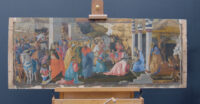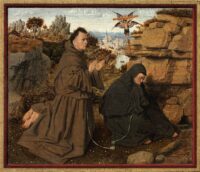 The removal of the frame encasing Sandro Botticelli and Filippino Lippi’s Adoration of the Kings in London’s National Gallery has revealed original paint, giving conservators a rich source of information to restore the tempera-on-wood masterpiece. The work has suffered hardships in the six centuries since it was painted, some accidental (water damage), some blunderous (drastic overcleaning). It was bought by The National Gallery in 1857, and it was so brutally “restored” that many details were lost.
The removal of the frame encasing Sandro Botticelli and Filippino Lippi’s Adoration of the Kings in London’s National Gallery has revealed original paint, giving conservators a rich source of information to restore the tempera-on-wood masterpiece. The work has suffered hardships in the six centuries since it was painted, some accidental (water damage), some blunderous (drastic overcleaning). It was bought by The National Gallery in 1857, and it was so brutally “restored” that many details were lost.
In order to conserve it by modern standards, the National Gallery team first took X-rays which showed that the painting continued underneath the top of the frame. When restorer Jill Dunkerton and conservator Britta New removed it from its frame, they found that while very dirty, the paint underneath was in excellent condition compared to the main part of the composition which was sadly flattened by the terrible 19th century cleaning. The unframing also made new sense of the proportions of the figures and their grouping in three levels. The bottom of the frame had hidden a step and made the figures on the left and center look like they were different sizes for no reason.
The painting’s dimensions — 20 inches high and 54 inches wide — suggest that it may have originally been designed to fit a piece of furniture, so it’s unclear when it was first framed. The one that was removed dates to the 19th century when framers in Florence created a custom-carved frame that would accommodate the concave warp the long panel had developed by then.
Here’s a video of the frame being removed piece by piece:
It was painted around 1470, early in the careers of Sandro Botticelli and Filippino Lippi. Botticelli had just struck out on his own after working as an apprentice in the studio of Fra Filippo Lippi, Filippino’s natural father, who had died the year before. Filippino completed his apprenticeship in Botticelli’s new workshop and was listed as his sole assistant in the guild records of 1472. In an unusual twist, The Adoration of the Kings was started by Filippino and then completed by Sandro. Generally apprentices completed the works of the masters, not the other way around. Botticelli is likely responsible for the crowd of kings, horses and onlookers on the left, the dwarf and the man gazing upwards in the central section and the shepherds on the right; Filippino’s hand is evident in the Virgin and Child, the kneeling king kissing Christ’s foot and the entourage behind him.
 The distant town, lake and rocks in the center background were copied from Saint Francis of Assisi Receiving the Stigmata by Jan van Eyck, now in the Philadelphia Museum of Art. Early Northern Renaissance art was much in fashion in Florence at the time, and drawings of important works made their way south where Florentine artists used versions of them in their own designs.
The distant town, lake and rocks in the center background were copied from Saint Francis of Assisi Receiving the Stigmata by Jan van Eyck, now in the Philadelphia Museum of Art. Early Northern Renaissance art was much in fashion in Florence at the time, and drawings of important works made their way south where Florentine artists used versions of them in their own designs.
Botticelli and Lippi’s northern inspiration gave Jill Dunkerton a unique window into what the original would have looked like before the scrubbing. She was able to study Van Eyck’s piece to recreate some of the lost detail, and the results of her retouching are pretty spectacular so far. Check out this video of her at work. The before and after of the rocks is a particularly striking contrast.